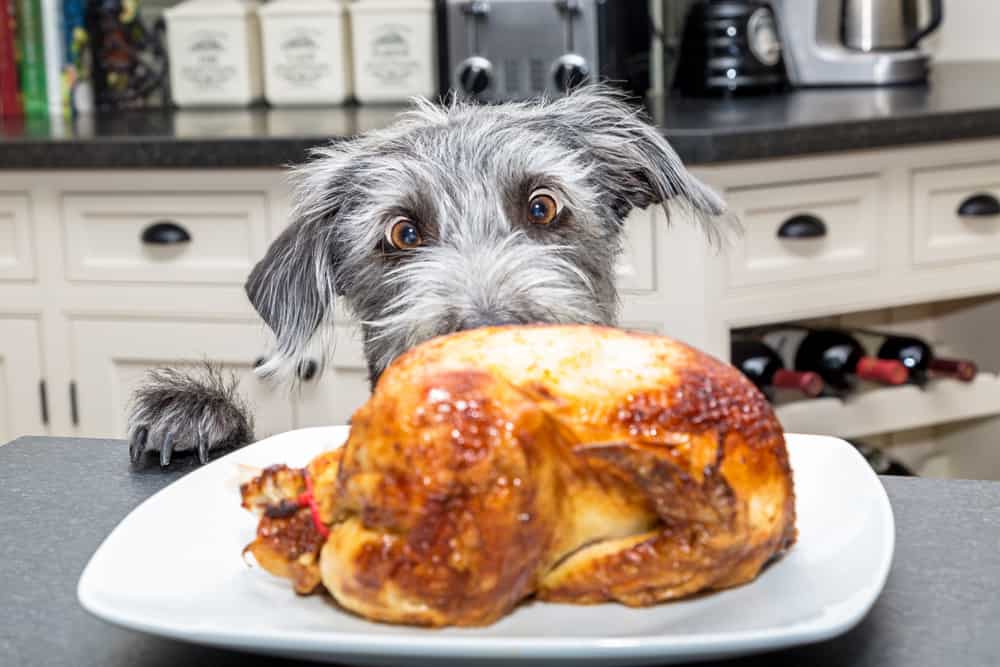Owning a dog brings immense joy and responsibility. One of the primary concerns for pet owners is ensuring their furry friend is adequately fed. Recognizing when your canine companion is hungry can be a bit challenging, especially for new pet owners. But with some keen observation and knowledge of common hunger cues, you can ensure your pet is never left with an empty stomach.

Understanding Canine Hunger
Every dog is unique, with its own set of dietary needs. Factors such as age, breed, activity level, and health can influence a dog's appetite. Therefore, dog appetite indicators will vary, and what's normal for one dog might not be for another. It's essential to be in tune with these variations to read their hunger cues correctly.
Physical Signs a Dog is Hungry
- Body Language: A dog that's hungry will often be more alert, with ears perked up and a tail that's wagging slightly faster than usual. Some dogs might nudge their food bowl or stand near where their food is usually kept.
- Vocalization: While barks, whines, or howls can mean many things, when combined with other hunger signs, they can indicate hunger. Listening to the frequency and tone of these sounds can help you discern their meaning.
- Staring & Following: One of the most obvious signs is when your dog stares at you, especially if this gaze is frequently directed towards the kitchen or the place where you store their food. If they start following you around more than usual, especially during their feeding times, they might be hinting at something.
- Licking & Chewing: Dogs may often lick their lips or start chewing on random objects when they're hungry. It's their way of showing restlessness and a craving for something to eat.
Decoding Behavioral Signs
Apart from the physical signs, dogs also exhibit specific behaviors that indicate hunger.
- Increased Activity: If your dog seems more active, pacing around, especially near meal times, it's a clear indication of hunger.
- Seeking Behavior: Dogs will often sniff around, searching for food or treats. If you find your pet rummaging through the trash or sniffing around more than usual, it's a hint.
Tips to Address Dog Hunger Effectively
- Consistent Feeding Times: Establishing a routine helps. Set feeding times ensure that your dog's hunger is addressed at regular intervals, making them less likely to beg or show signs of hunger outside these times.
- Choose Quality Food: It's not just about feeding them on time but also ensuring that what they eat is nutritious. High-quality dog food that caters to their age, breed, and health needs is essential.
- Monitor Health Regularly: A sudden change in appetite can indicate health issues. If your dog is eating less or more than usual, or showing signs of hunger more frequently, it's a good idea to consult a vet.

Recognizing Unique Hunger Patterns
Every dog, like humans, has individual patterns when it comes to hunger. While the general indicators mentioned above are commonly seen in most dogs, there might be specific patterns that only your dog displays. Over time, as you bond more with your pet, you'll start noticing these unique signs.
Age-related Hunger Cues
- Puppies: Puppies are growing rapidly and require more frequent feeding. They might get hungry more often and can become restless, pawing at you or their food container.
- Adult Dogs: Mature dogs tend to have established eating habits. If an adult dog starts showing signs of hunger outside its regular feeding times, it might be worth reviewing the amount or type of food you're giving them.
- Senior Dogs: Older dogs might have decreased appetite due to health issues or a slower metabolism. However, if they're showing signs of hunger, ensure that their food is suitable for their age and health condition.
The Role of Exercise in Hunger
Physical activity plays a significant role in a dog's appetite. A dog that has been active, played a lot, or had an extended exercise session will likely be hungrier.
Post-Exercise Hunger
If your dog is showing signs of hunger after a rigorous play session or walk, it's perfectly normal. Ensure they have access to fresh water at all times and consider giving them a small, healthy treat post-exercise. Remember, always allow some time between feeding and vigorous activity to prevent potential stomach issues.
Balancing Diet with Activity
An active dog will require more calories. If you've recently increased your pet's activity level, you might need to adjust their food intake accordingly. Consult with your vet to find the best diet that aligns with your dog's energy expenditure.
Dietary Changes and Their Impact
As your dog progresses through different life stages or experiences health challenges, their diet might require adjustments. Understanding how these changes affect their hunger cues can be pivotal in providing optimal care.
Switching Dog Foods
- Taste and Preference: Just as humans have food preferences, dogs do too. If you switch to a new brand or type of dog food and notice your dog becoming more eager during meal times or seeking food more often, they might prefer the new taste. Conversely, if they seem less enthusiastic or leave food uneaten, they might not favor the new choice.
- Digestibility: Higher quality foods are often more easily digestible and contain fewer fillers. This can lead to your dog feeling full for longer and displaying fewer hunger cues. If you've switched to a premium food and notice reduced begging, it's not necessarily a sign of reduced appetite but perhaps better satiety.
Health Conditions and Appetite
Certain health conditions can influence a dog's appetite. Conditions like diabetes, thyroid imbalances, or digestive issues can either increase or decrease hunger.
- Increased Hunger: Conditions like diabetes can make a dog feel constantly hungry. If your pet is showing intensified hunger cues, along with other symptoms like increased thirst or frequent urination, it's essential to consult a vet.
- Reduced Appetite: Digestive issues, dental problems, or certain infections can diminish a dog's appetite. If your dog is suddenly disinterested in food or eats far less than usual, a vet check-up is crucial.
The Importance of Hydration
While understanding hunger cues is vital, it's equally important to monitor your dog's water intake. A sudden increase in thirst can sometimes be mistaken for hunger. Ensure your dog always has access to fresh water, and if you notice them drinking excessively, it could be indicative of an underlying health issue.

Seasonal Influences on Appetite
Just as humans might eat more or less depending on the season, dogs too can have seasonal appetite fluctuations.
- Hot Weather: During the warmer months, it's not uncommon for dogs to display a reduced appetite. It's crucial, however, to ensure they're staying hydrated.
- Cold Weather: In colder seasons, especially if your dog spends a lot of time outdoors, they might show increased hunger cues due to higher energy expenditure to stay warm.
Behavioral Aspects of Canine Hunger
Dogs, like humans, can display certain behaviors influenced by more than just physical hunger. Sometimes, the way they act around food or feeding times can be driven by learned behaviors, emotions, or environmental triggers.
Boredom vs. Hunger
Dogs often seek food not just because they're hungry, but sometimes out of sheer boredom. If you find your dog frequently hovering around the food bowl, but they've been fed adequately, consider engaging them in stimulating activities or toys. Bored dogs need mental and physical challenges to keep them occupied.
Emotional Eating
Yes, dogs can be emotional eaters too! Stress, anxiety, or changes in their environment, like a new family member or moving to a new house, can lead to changes in their eating habits. It's crucial to differentiate between emotional hunger cues and genuine physical hunger to address the root cause effectively.
Training and Treats
Training sessions often involve treats as rewards. However, if treats are given too frequently or are too calorie-dense, your dog might seem less hungry during regular meal times. Balance is key. Opt for low-calorie treats, and ensure training doesn't interfere with their primary diet.
Environmental Triggers
- Feeding Environment: The place and manner in which a dog is fed can influence their appetite. Ensure they have a quiet, stress-free spot to eat. Sudden changes, like moving their bowl, can sometimes disrupt their eating patterns.
- Shared Spaces: If you have multiple pets, competition for food might make it seem like they're always hungry. Monitor each pet's intake to ensure everyone gets their fair share.
Dietary Supplements and Hunger
If your dog is on supplements, be it for health reasons or to enhance their diet, these can sometimes influence their appetite. Some supplements might increase hunger, while others can make them feel fuller. Always consult with your vet regarding any potential side effects of dietary supplements.

Social Dynamics and Canine Hunger
Dogs, being pack animals by nature, have intricacies in their social dynamics which can affect their feeding habits and perceptions of hunger.
The Alpha Dynamic
In multi-dog households, there's often an "alpha" or a dominant dog. This dog might eat first or might even guard food from others. Sometimes, less dominant dogs might appear hungrier more often, not because they need more food, but because they're trying to find moments to eat without the alpha's interference.
Human Interaction and Feeding
Dogs often associate their human family members with food. Your behavior around feeding times, the tone of voice you use, and even specific words or phrases ("dinner time" or "want a treat?") can elicit excitement or anticipation from your dog. This doesn't always mean they're hungry. Sometimes, they're just responding to the positive associations they've formed around those interactions.
Feeding Rituals and Their Impact
Rituals around feeding times, like asking your dog to sit before they get their meal or making them wait patiently while you prepare their food, can instill discipline. But they also create patterns of behavior. If a dog is exhibiting signs of hunger around these rituals, they might be responding to the ritual itself rather than actual hunger.
The Influence of Snacking
Much like humans, dogs can also be prone to the allure of snacks and treats.
Over-Treating
It's hard to resist those puppy eyes, but giving in to your dog's pleas for treats too often can lead to overfeeding. This can skew their actual hunger patterns and might make it harder to determine when they're genuinely hungry versus when they're just looking for an extra treat.
Healthy Snacking
If you do decide to give your dog snacks between meals, opt for healthier options like carrot sticks, apple slices (without seeds), or specially formulated dog treats that consider nutritional balance.
The Role of Technology in Feeding
The rise of smart home gadgets has also seen the advent of automated dog feeders. These devices can be programmed to feed your dog at set intervals.
Pros:
- Consistency in feeding times.
- Portion control, ensuring your dog doesn't overeat.
Cons:
- Reduced human interaction around feeding.
- Potential malfunction or misprogramming might lead to overfeeding or underfeeding.
Striking a Balance
While technology can assist in feeding, nothing replaces the bond formed during feeding times. Ensure that while gadgets might help, you're still present and observing your dog during meals.

Conclusion:
In understanding "How to Tell if a Dog is Hungry," it's imperative to recognize both universal and unique hunger cues, from body language to vocal signals. Factors like age, health conditions, dietary changes, behavioral aspects, and social dynamics play pivotal roles in a dog's appetite. Environment, emotional triggers, training routines, and even technological influences can alter feeding patterns.
Balancing regular meals with healthy snacking, maintaining consistent feeding times, and ensuring quality nutrition are paramount. Observing and adapting to these multifaceted cues and patterns ensures holistic care, fostering a deeper bond between pet and owner and promoting canine well-being.
Frequently Asked Questions (FAQs)
- What are the common signs that a dog is hungry?
- Common signs include increased alertness, perked-up ears, tail wagging, nudging their food bowl, staring or following you, vocalizations like barking or whining, and licking or chewing objects.
- How do age and health affect a dog's appetite?
- Puppies usually require frequent feeding due to rapid growth. Adult dogs have established routines, while senior dogs might eat less due to health issues or reduced metabolism. Certain conditions like diabetes can also alter a dog's hunger cues.
- Can behavioral aspects, like boredom, affect a dog's hunger signs?
- Absolutely! Dogs might seek food out of boredom or due to emotional triggers. It's essential to differentiate between actual hunger and behaviors stemming from other factors.
- How do I distinguish between genuine hunger and a dog seeking treats?
- Regular feeding schedules, observing frequency of hunger cues, and understanding your dog's unique behavior patterns can help differentiate between genuine hunger and a craving for extra treats.
- Does the feeding environment influence a dog's appetite?
- Yes, a consistent, stress-free feeding environment ensures a dog eats comfortably. Changes in their feeding spot or competition from other pets can impact their appetite.
- Are there any technology tools to help manage dog feeding?
- There are automated dog feeders available, allowing scheduled feedings. While they provide consistency, it's essential to monitor their operation and ensure personal interaction during feeding times.
- How do dietary supplements influence canine hunger?
- Some supplements can affect a dog's appetite, either increasing or decreasing their hunger cues. It's always best to consult with a vet regarding potential supplement effects.
- Are there seasonal influences on a dog's appetite?
- Yes, during hotter months, dogs might eat less, while in colder seasons, especially if they're active outdoors, they might consume more due to increased energy expenditure.
- How important is hydration in relation to dog hunger?
- Extremely. Sometimes, increased thirst can be mistaken for hunger. Always ensure your dog has access to fresh water and monitor any drastic changes in drinking habits.
- How can I ensure I'm feeding my dog the right amount?
- Regular vet check-ups, monitoring your dog's weight, and understanding their unique needs based on age, activity level, and health will help you determine the optimal feeding amount.






